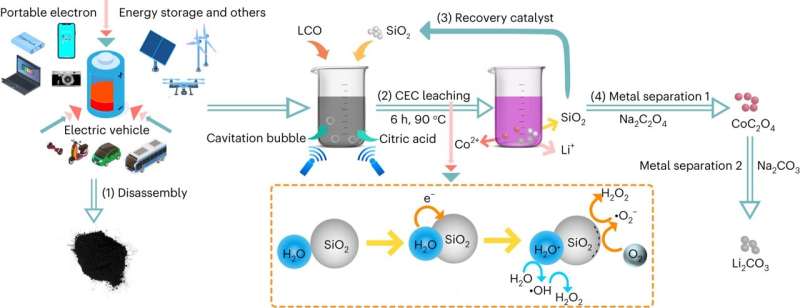September 21, 2023 feature
This article has been reviewed according to Science X's editorial process and policies. Editors have highlighted the following attributes while ensuring the content's credibility:
fact-checked
peer-reviewed publication
trusted source
proofread
New method to recycle materials inside lithium-ion batteries

Lithium-ion batteries (LIBs), which store energy leveraging the reversible reduction of lithium ions, power most devices and electronics on the market today. Due to their wide range of operating temperatures, long lifespan, small size, fast charging times and compatibility with existing manufacturing processes, these rechargeable batteries can greatly contribute to the electronics industry, while also supporting ongoing efforts towards carbon neutrality.
The affordable and eco-friendly recycling of used LIBs is a long sought-after goal in the energy sector, as it would improve the sustainability of these batteries. Existing methods, however, are often ineffective, expensive or harmful to the environment.
Moreover, LIBs heavily rely on materials that are becoming less abundant on Earth, such as cobalt and lithium. Approaches that enable the reliable and cost-effective extraction of these materials from spent batteries would drastically reduce the need to source these materials elsewhere, thus helping to meet the growing LIB demand.
Researchers at the Chinese Academy of Sciences recently devised a new approach based on so-called contact-electro-catalysis, which could enable the recycling of spent LIB cells. Their method, introduced in Nature Energy, leverages the transfer of electrons that takes place during liquid-solid contact electrification to generate free radicals that initiate desired chemical reactions.
"With the global trend towards carbon neutrality, the demand for LIBs is continuously increasing," Huifan Li, Andy Berbille and their colleagues wrote in their paper. "However, current recycling methods for spent LIBs need urgent improvement in terms of eco-friendliness, cost and efficiency. We propose a mechano-catalytic method, dubbed contact-electro-catalysis, utilizing radicals generated by contact electrification to promote the metal leaching under the ultrasonic wave. We also use SiO2 as a recyclable catalyst in the process."
As part of their recent study, Li, Berbille and their colleagues set out to explore the possibility that contact-electro-catalysis could replace chemical agents typically used to recycle LIBs. To do this, they used the technique to elicit continuous solid-liquid contact and separation through cavitation bubbles, under ultrasound waves.
This enabled the constant generation of reactive oxygen through the electrification of contacts. They then assessed the effectiveness of this strategy for recycling lithium and cobalt in worn out LIBs.
"For lithium cobalt (III) oxide batteries, the leaching efficiency reached 100% for lithium and 92.19% for cobalt at 90°C within six hours," Li, Berbille and their colleagues wrote in their paper. "For ternary lithium batteries, the leaching efficiencies of lithium, nickel, manganese and cobalt reached 94.56%, 96.62%, 96.54% and 98.39% at 70°C, respectively, within six hours."
In initial tests, the approach proposed by this team of researchers achieved highly promising results, highlighting its potential for supporting the low-cost, sustainable and large-scale recycling of the expensive and highly sought after materials inside LIBs. Future studies could help to perfect this method, while further assessing its advantages and limitations, potentially paving the way towards its deployment in real-world settings.
"We anticipate that this method can provide a green, high efficiency and economic approach for LIB recycling, meeting the exponentially growing demand for LIB productions," the researchers wrote in their paper.
More information: Huifan Li et al, A contact-electro-catalytic cathode recycling method for spent lithium-ion batteries, Nature Energy (2023). DOI: 10.1038/s41560-023-01348-y
© 2023 Science X Network


















